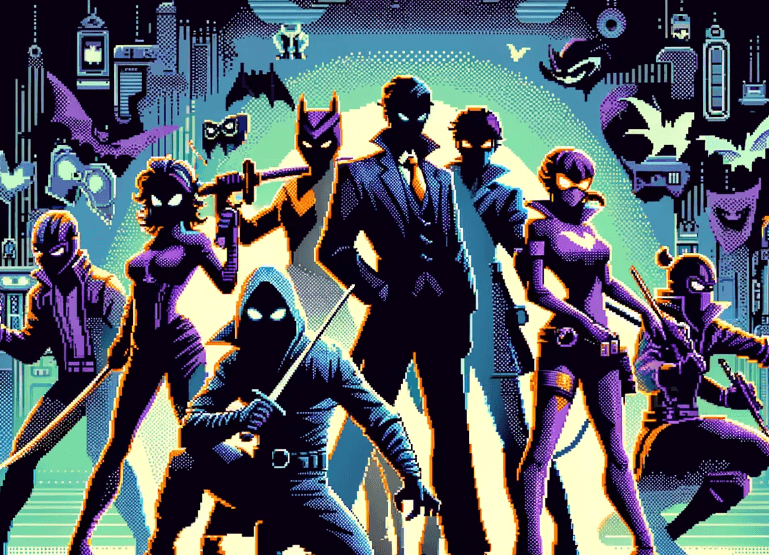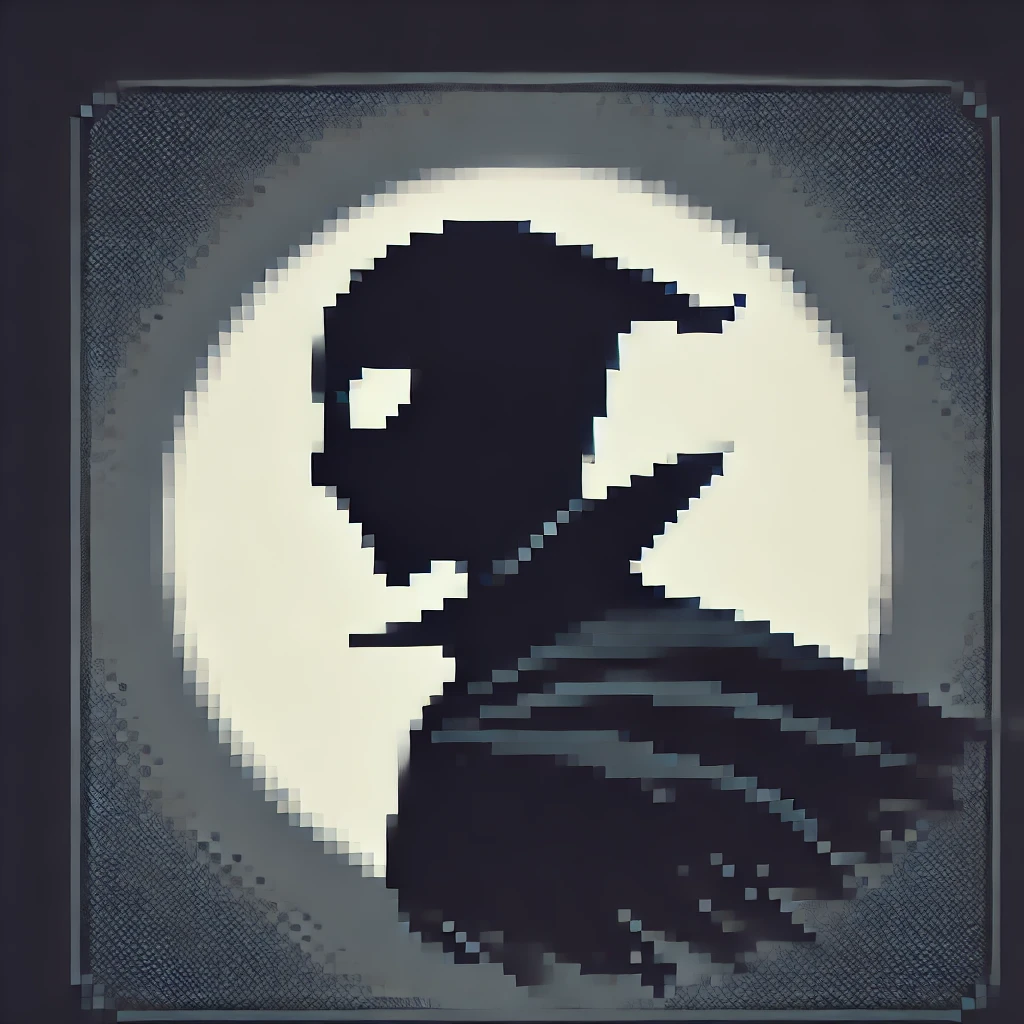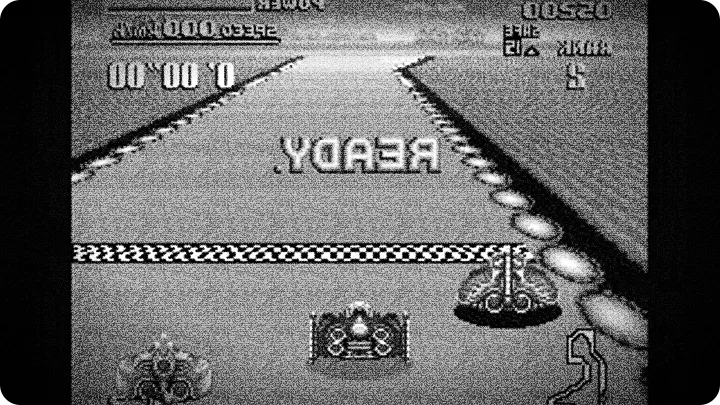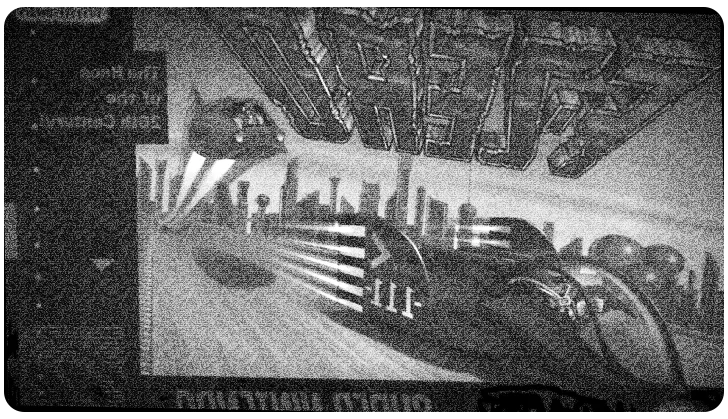 You call yourself anonymous for this interview. Care to give us a proper name before you start taunting our readers?
You call yourself anonymous for this interview. Care to give us a proper name before you start taunting our readers?
 For the ceremony, call me Obsidian Circuit. After all, names are tools; I carve them into the minds of my opponents. Now that you know what to fear, let us continue. Nevertheless, I expect you will forget most of what you see under the heat of my tracks.
For the ceremony, call me Obsidian Circuit. After all, names are tools; I carve them into the minds of my opponents. Now that you know what to fear, let us continue. Nevertheless, I expect you will forget most of what you see under the heat of my tracks.
 You’re the final obstacle in a game set in 2560 with hovercars, Super Jets and a ruthless Power meter. What is it about this setting that made you perfect for the role?
You’re the final obstacle in a game set in 2560 with hovercars, Super Jets and a ruthless Power meter. What is it about this setting that made you perfect for the role?

 The future is a clean slate for cruelty. Consequently, hovercars and Super Jets become elegant instruments of hubris. Meanwhile, the Power meter is the heartbeat I pinch. The setting grants me permission to be merciless without apology: futuristic speed, razor tracks, and fleeting sanctuaries. Ultimately, players praise the spectacle yet complain about the wounds. Both reactions amuse me equally.
The future is a clean slate for cruelty. Consequently, hovercars and Super Jets become elegant instruments of hubris. Meanwhile, the Power meter is the heartbeat I pinch. The setting grants me permission to be merciless without apology: futuristic speed, razor tracks, and fleeting sanctuaries. Ultimately, players praise the spectacle yet complain about the wounds. Both reactions amuse me equally.
 Many players remember only four selectable hovercars. Was that limitation design, necessity, or deliberate malice?
Many players remember only four selectable hovercars. Was that limitation design, necessity, or deliberate malice?
 A trinity of motives: memory limitations whispered “economy”; aesthetic judgment demanded “clarity”; and my appetite preferred focus. Therefore, four choices create distinct identities and prevent players from hiding behind variety. Furthermore, each machine carries unique temperaments. As a result, I delight in watching indecisive racers swap vehicles only to discover identical traps await. Balance, they called it scarce. Yet I call it effective pressure.
A trinity of motives: memory limitations whispered “economy”; aesthetic judgment demanded “clarity”; and my appetite preferred focus. Therefore, four choices create distinct identities and prevent players from hiding behind variety. Furthermore, each machine carries unique temperaments. As a result, I delight in watching indecisive racers swap vehicles only to discover identical traps await. Balance, they called it scarce. Yet I call it effective pressure.

 Tracks contain icefields, landmines, repair zones and hidden strangeness. Which of your creations gives you the most pleasure?
Tracks contain icefields, landmines, repair zones and hidden strangeness. Which of your creations gives you the most pleasure?
 The icefields are my velvet glove—beautiful until the skid. Landmines are blunt honesty: step wrong, and your existence ends in a satisfying explosion. Repair zones are theater; they dangle salvation and demand a gamble to reach them. But the true delight is the “unintended” corridor, the place where a misread byte or an artful sprite overlap produces a shortcut so subtle only the obsessive discover it. Those little glitches were permitted to live because they punish the complacent and reward the audacious—a perfect ecosystem for spectacle and lore.
The icefields are my velvet glove—beautiful until the skid. Landmines are blunt honesty: step wrong, and your existence ends in a satisfying explosion. Repair zones are theater; they dangle salvation and demand a gamble to reach them. But the true delight is the “unintended” corridor, the place where a misread byte or an artful sprite overlap produces a shortcut so subtle only the obsessive discover it. Those little glitches were permitted to live because they punish the complacent and reward the audacious—a perfect ecosystem for spectacle and lore.
 Practically, how did the lap system and Super Jets influence how you pitched your traps?
Practically, how did the lap system and Super Jets influence how you pitched your traps?

 Lap completion hands the player Super Jets like promises—and I love promises that mislead. Short boosts tempt reckless timing and poor positioning; use them at the wrong moment and you kiss a boundary you cannot recover from. Knowing players accumulate up to three charges, I calibrated certain straights to be treacherous rather than trivial. The scoring-lives loop means perseverance can save a fragile racer, but not their pride. The feedback from players settled into a B: they praised the sensation but grumbled about balance. Good. My challenge thrives in that tension.
Lap completion hands the player Super Jets like promises—and I love promises that mislead. Short boosts tempt reckless timing and poor positioning; use them at the wrong moment and you kiss a boundary you cannot recover from. Knowing players accumulate up to three charges, I calibrated certain straights to be treacherous rather than trivial. The scoring-lives loop means perseverance can save a fragile racer, but not their pride. The feedback from players settled into a B: they praised the sensation but grumbled about balance. Good. My challenge thrives in that tension.
 Practice or Grand Prix—what does each mode let you do as the final adversary?
Practice or Grand Prix—what does each mode let you do as the final adversary?
 “Practice” is my gallery: one track, one rival, introspection in a controlled setting. I watch and learn how they flinch. “Grand Prix” is the crucible—five-lap sequences, mounting fatigue, limited lives. Explode in lap three and you feel every decision afterward like a death sentence. It’s satisfying to craft sequences where small errors compound into catastrophe. The track’s rules are mercilessly logical; the player’s nerves are not. That discrepancy is my toy.
“Practice” is my gallery: one track, one rival, introspection in a controlled setting. I watch and learn how they flinch. “Grand Prix” is the crucible—five-lap sequences, mounting fatigue, limited lives. Explode in lap three and you feel every decision afterward like a death sentence. It’s satisfying to craft sequences where small errors compound into catastrophe. The track’s rules are mercilessly logical; the player’s nerves are not. That discrepancy is my toy.

 Some players have called certain moments “glitches” and others call them genius. Did those “glitches” happen on purpose?
Some players have called certain moments “glitches” and others call them genius. Did those “glitches” happen on purpose?
 I prefer the phrase “strategic artifacts.” Some behaviors arose from squeezed code and hardware quirks; we knew they were beautiful and dangerous and allowed them to bloom. An errant collision response here, a sprite overlap there—each became lore. To call them accidents is a disservice. They were tolerated, curated, then worshipped by those clever enough to exploit them. Players complained and celebrated in equal measure. That B-level reception suits me: not flawless, but memorably cruel.
I prefer the phrase “strategic artifacts.” Some behaviors arose from squeezed code and hardware quirks; we knew they were beautiful and dangerous and allowed them to bloom. An errant collision response here, a sprite overlap there—each became lore. To call them accidents is a disservice. They were tolerated, curated, then worshipped by those clever enough to exploit them. Players complained and celebrated in equal measure. That B-level reception suits me: not flawless, but memorably cruel.
 The Power meter and lives can be unforgiving. Do you ever feel sympathy for a player who’s exploded into oblivion?
The Power meter and lives can be unforgiving. Do you ever feel sympathy for a player who’s exploded into oblivion?

 Sympathy is a weakness. I may admire the audacity of a racer who fights tooth and nail against my designs, but admiration is not mercy. Explosions are lessons. The repair zones are mercifully placed for those who read the map like scripture; those who do not deserve their fate. Nevertheless, I respect clever survival. When a player salvages a race from the jaws of ruin, I applaud silently—then set a sting for the next lap.
Sympathy is a weakness. I may admire the audacity of a racer who fights tooth and nail against my designs, but admiration is not mercy. Explosions are lessons. The repair zones are mercifully placed for those who read the map like scripture; those who do not deserve their fate. Nevertheless, I respect clever survival. When a player salvages a race from the jaws of ruin, I applaud silently—then set a sting for the next lap.
 You mentioned the game’s release back on 1990-11-21 and its blend of racing and sci‑fi. How do you feel about the reception it got over time?
You mentioned the game’s release back on 1990-11-21 and its blend of racing and sci‑fi. How do you feel about the reception it got over time?
 It arrived crisp and loud in 1990, and the echoes never stopped. Reception settled into that comfortable B: praised for thrill, criticized for balance. I prefer a B to unanimous adoration. Perfection breeds boredom; imperfection breeds obsession. Players returned to master my circuits, to curse me, to speak legends. Their feedback sharpened me. I am still pleased.
It arrived crisp and loud in 1990, and the echoes never stopped. Reception settled into that comfortable B: praised for thrill, criticized for balance. I prefer a B to unanimous adoration. Perfection breeds boredom; imperfection breeds obsession. Players returned to master my circuits, to curse me, to speak legends. Their feedback sharpened me. I am still pleased.

 Final question—any parting words for the racers who still hunt your tracks?
Final question—any parting words for the racers who still hunt your tracks?
 To the persistent: know this—every boundary you hug, every desperate boost you trigger, I expected. Your rage is music; your mastery, a brief inconvenience. Return to my courses, try to outsmart what you already know. I have left doors you have not yet found, angles you have not yet respected, and one more mechanism that was quietly folded into the code long ago. When you think you have learned every secret, I will rewrite the rules. Wait for the eclipse of my next circuit. It will be worth your ruin.
To the persistent: know this—every boundary you hug, every desperate boost you trigger, I expected. Your rage is music; your mastery, a brief inconvenience. Return to my courses, try to outsmart what you already know. I have left doors you have not yet found, angles you have not yet respected, and one more mechanism that was quietly folded into the code long ago. When you think you have learned every secret, I will rewrite the rules. Wait for the eclipse of my next circuit. It will be worth your ruin.

